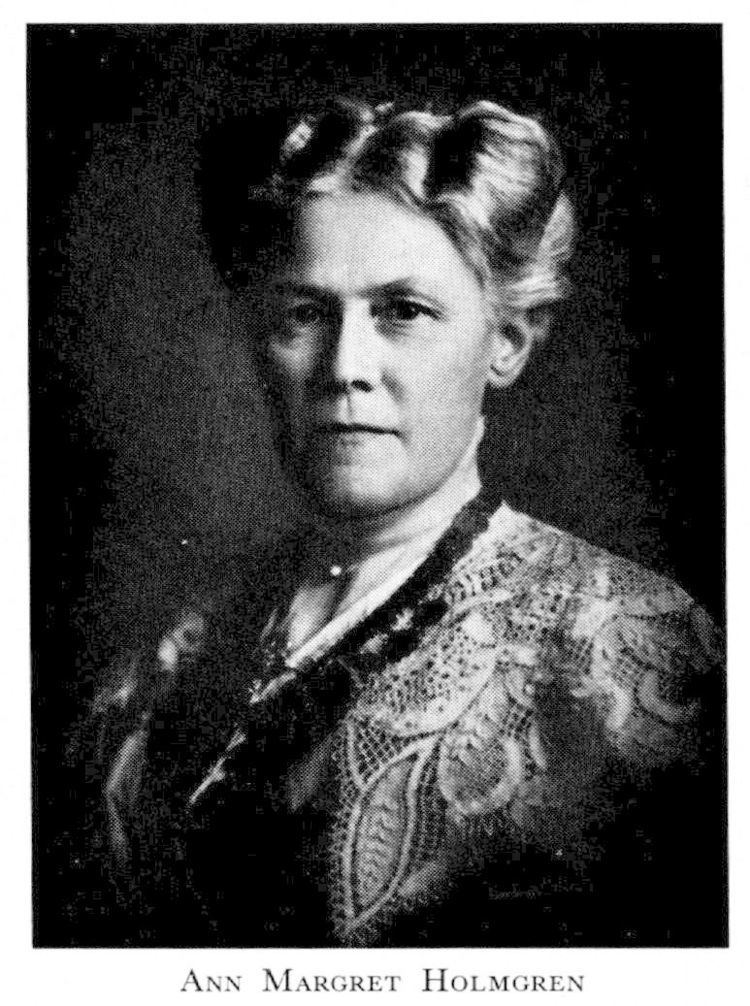Name Ann-Margret Holmgren Grandchildren Birgit Holmgren Parents Jacob Nils Tersmeden | Died October 12, 1940 Role Author | |
 | ||
Children Israel Holmgren, Torsten Holmgren, Bjorn Frithiofsson Holmgren, Gunnar Holmgren | ||
Anna Margareta "Ann-Margret" Holmgren, née Tersmeden (17 February 1850 – 12 October 1940), was a Swedish author, feminist and pacifist.

Life and career
She was born at Hässle Manor, Uppland, the daughter of the conservative politician and courtier, nobleman Jacob Nils Tersmeden and Baroness Augusta Jacquette Cederström. In 1869, she married the doctor Frithiof Holmgren, professor at Uppsala University. Their home in Uppsala, Villa Åsen, was a discussion forum for intellectual students and a centre for radical and modern ideas. Among the ideas modern in this radical circles was the introduction of a republic, democracy, suffrage, workers rights, contraception and atheism. This is thought to have given Holmgren radical sympathies, and she participated in the radical paper Verdandi in 1898–1905.
Ann Margret Holmgren was active as a writer under the pseudonym "Märta Bolle". She published Fru Stråhle. Tidsbilder ur tre släktled (1894) and När riddar Ulf suckar. Ur familjekrönikan på Höögsborg (1896), both translated to German.
After the death of her husband in 1897, she moved to Stockholm, where was inspired by her friends Ellen Key and Lydia Wahlström to engage in gender equality. As a feminist, Holmgren caused considerable controversy by her support for love and sex outside of marriage, in conflict with the contemporary sexual double standard. Personally, she did not support the official parole of the suffrage movement that women should be given the right to vote on "equal terms as men", because that would in fact mean that only women of legal majority would be able to vote; this would exclude married women, who were under the guardianship of their spouses, and Holmgren therefore also demanded the right for married women to vote, which meant that she demanded the right for married women to be declared adults.
In 1902, two motions regarding women suffrage reform were presented to the Swedish Parliament. One was from the Minister of Justice Hjalmar Hammarskjöld, who suggested that married men be given two votes, as they could be regarded to vote in place of their wives as well. The other motion was presented by Carl Lindhagen, who suggested women suffrage. The Hammarskjöld suggestion aroused anger among women's rights activists, who formed a support group for the Lindhagen motion. On 4 June 1902, Föreningen för Kvinnans Politiska Rösträtt (FKPR) was founded: initially a local Stockholm society, it became a national organization the year after. Holmgren was the Vice Chairman of the Stockholm branch of the National Association for Women's Suffrage or LKPR in 1902–1904 and the secretary of the executive comity of the Swedish Society for Woman Suffrage in 1903–1906. Within the suffrage movement, Ann-Margret Holmgren's most important role was that of a speaker: she was the first member after the foundation of the movement to travel nationwide to speak, gather sympathisers and establish local sections of the suffrage movement, a task in which she made use of her wide net of contacts among former Uppsala students. On her 60th birthday 1910, she was celebrated by the LKPR with a golden chain of 60 links, as she had founded 60 local branches of the women's suffrage society.
Ann-Margret Holmgren was also vice chairman of Sveriges kvinnliga fredsförening (The Swedish Women's Peace Association) in 1901-10, honorary member of Nordic Museum and the Philochoros Society. After the LKPR was dissolved after the introduction of woman suffrage, Holmgren was one of the founders of the Svenska kvinnors medborgarförbund (Citizen Society of Swedish Women) in 1921.
